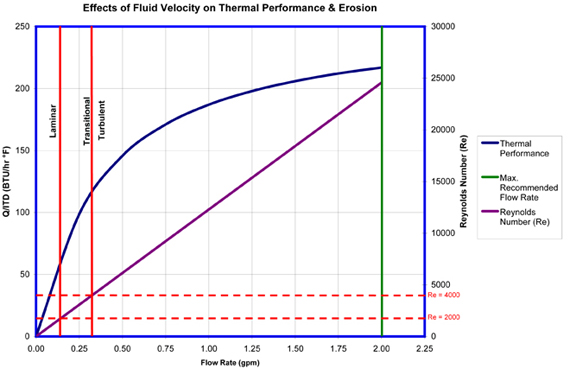Preventing Erosion-Corrosion in Cooling Systems
Heat exchanger and cold plate are used in cooling applications to remove and transfer heat from one place to another using a heat transfer fluid such as water, ethylene glycol and water solution, oil, etc. There are thousands of combinations of fluids and fluid path materials used in these applications. One of the main criteria for selecting the fluid path materials in these components should be the materials' ability to resist corrosion. Corrosion comes in many different forms, including "erosion-corrosion". It is important to know the fluids' properties as well as the materials' properties in order to minimize erosion-corrosion and optimize system performance and life.
What is erosion-corrosion?
Erosion-corrosion is the acceleration in the rate of corrosion in metal due to the relative motion of a fluid and a metal surface. It typically occurs in pipe bends (elbows), tube constrictions, and other structures that alter flow direction or velocity. The mechanism for this type of corrosion is the continuous flow of fluid, which removes any protective film or metal oxide from the metal surface. It can occur both in the presence and in the absence of suspended matter in the flow stream. In the presence of suspended matter, the effect is very similar to sandblasting, and even strong films can be removed at relatively low fluid velocities. Once the metal surface is exposed, it is attacked by the corrosive media and eroded away by the fluid friction. If the passive layer of metal oxide cannot be regenerated quickly enough, significant damage may occur.
Some materials are more resistant than others to erosion-corrosion under the same fluid conditions. Erosion-corrosion is most prevalent in soft alloys, such as copper and aluminum. Although increasing the flow rate of the fluid in your cooling application may increase its performance, it may also increase erosion-corrosion. Therefore, it is important to determine how great an impact increasing the flow rate will have on your thermal performance, as you may see minimal improvement in performance with a significant drop in the longevity of your heat exchanger or cold plate.
The following graph shows the effects of fluid velocity on performance and erosion on a 3/8 copper tube-fin liquid-to-air heat exchanger. The graph shows that in the turbulent region of flow (Re > 4000) and at volumetric flow rates of less than 2 gpm, water velocities are within the recommended values of less than 8 ft/sec (2 gpm) for copper tubing (see Table 1). Given the same diameter tubing, doubling the flow rate in the turbulent region of flow doesn't result in double the thermal performance. However, doubling the flow rate in the laminar and transitional regions can more than double the heat exchangers performance.

Table 1 - Maximum Recommended Water Velocities for Specific Materials
| Water |
Low carbon steel |
10 ft/sec |
Stainless steel |
15 ft/sec |
Aluminum |
6 ft/sec |
Copper |
8 ft/sec |
| 90-10 Cupronickel |
10 ft/sec |
| 70-30 Cupronickel |
15 ft/sec |
Controlling erosion-corrosion
Some methods for minimizing erosion-corrosion include improving the flow lines within the pipe by deburring (i.e. - smoothing out irregularities), allowing bends to have larger angles, and changing pipe diameters gradually rather than abruptly. Other methods include slowing the flow rate (minimizing turbulence), reducing the amount of dissolved oxygen, changing the pH, and switching the pipe material to a different metal or alloy.
In addition to the fluid path material used, it is also important to consider your fluid's temperature. At higher temperatures, flow rates should be lowered to minimize erosion-corrosion. For example, as a general rule, water flow velocities should not exceed 8ft/sec for cold water and 5 ft/sec for hot water (up to approximately 140 °F). In systems where water temperatures routinely exceed 140 °F, flow velocities should not exceed 3 ft/sec. For maximum recommended water velocities in other typical tube materials, refer to Table 1. For other fluids, the maximum allowable fluid velocity can be calculated from:
Allowable velocity for given fluid] = [Allowable velocity for water] x [Density of water/density of given liquid] 1/2
There will always be a trade-off between thermal performance and reliability/longevity in any cooling system. Increasing fluid flow will give you more cooling or performance only up to a point. After that, the increased fluid velocities may rapidly begin to erode and corrode the inside metal surface of the tubing. Designers should consider many different factors, such as the ones discussed above, in order to determine the best solution for their application.
|
